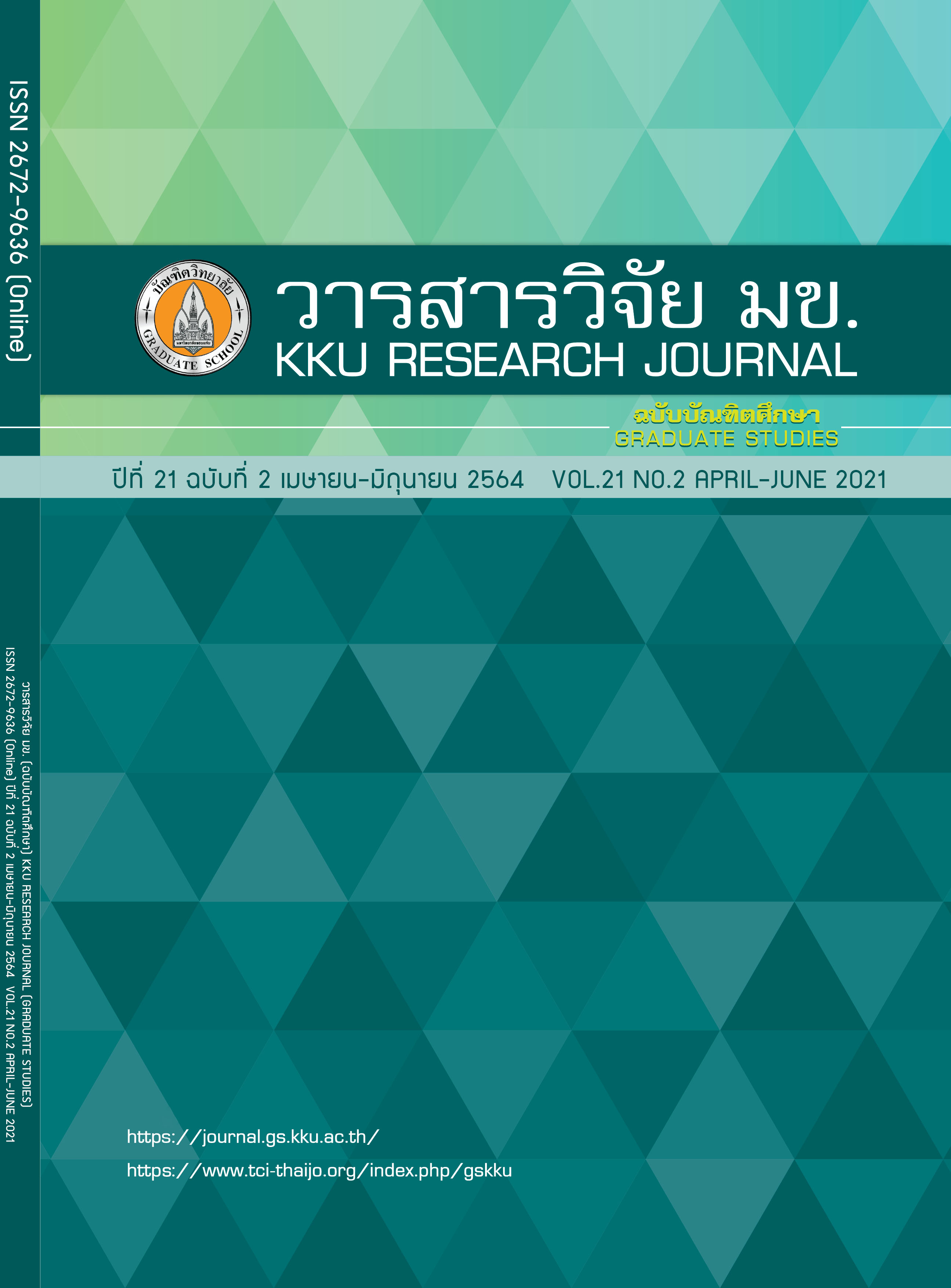Application of Lignin Separated from Paper and Pulp Wastewater as Adsorbent for Reactive Red 120 Removal
Keywords:
Reactive red 120 dye, Lignin, Paper and pulp industryAbstract
Lignin obtained from paper and pulp wastewater (LPW) treatment was applied as adsorbent for reactive red 120 (RR-120) removal.Separated LPW was characterized by Scanning Electron Microscope equipped with Energy Dispersive X-ray Spectrometer (SEM-EDS) and X-ray diffractometer (XRD). It was found that LPW shown characters of amorphous and Fe element appeared on LPW. The results of RR-120 removal by LPW was approximately 40% removed at temperature 303 K and when temperature of reaction increased then removal efficiency also increased. Adsorption kinetic followed Pseudo 2nd order. For the thermodynamic study, the reaction involves an endothermic nature (+H0) and spontaneous reactions (-
G0). An adsorption behavior fit well with Langmuir isotherm model which indicated that the adsorption process is physisorption and monolayer, and maximum adsorption capacity as 9.19 mg/g.
References
Kaykhaii M, Sasani M, Marghzari S. Removal of Dyes from the Environment by Adsorption Process. Chem Mater Eng. 2018;6(2):31–35.
Hao C, Yiu A, Tang L, Wang Y, Wai C. Dyes and Pigments E ff ect of reverse micelle-encapsulated reactive dyes agglomeration in dyeing properties of cotton. Dye Pigment. 2019;161(September 2018):51–57.
Zhang H, Yang H, Xie K, Hou A, Gao A. Dyes and Pigments Novel reactive dyes with intramolecular color matching combination containing di ff erent chromophores. Dye Pigment. 2018;159(2018):576–583.
Bazrafshan E, Ahmadabadi M, Mahvi AH. Reactive red-120 removal by activated carbon obtained from cumin herb wastes. Fresenius Environ Bull. 2013;22(2 A):584–590.
Kurade MB, Waghmode TR, Xiong JQ, Govindwar SP, Jeon BH. Decolorization of textile industry effluent using immobilized consortium cells in upflow fixed bed reactor. J Clean Prod. 2019;213(2019):884–891.
Lee W-N, Keng P-S, Hung Y-T, Ong S-T, Ha S-T. Dye Waste Treatment. Water. 2011;3(1):157–176.
Fungaro DA, Yamaura M, Carvalho TEM. Adsorption of anionic dyes from aqueous solution on zeolite from fly ash-iron oxide magnetic nanocomposite. J At Mol Sci. 2011;2(4):305–316.
Mubarak NSA, Jawad AH, Nawawi WI. Equilibrium, kinetic and thermodynamic studies of Reactive Red 120 dye adsorption by chitosan beads from aqueous solution. Energy, Ecol Environ. 2017;2(1):85–93.
Pangkumhang B, Jutaporn P, Sorachoti K, Khamdahsag P, Tanboonchuy V. Applicability of Iron (III) Trimesic (Fe-BTC) to Enhance Lignin Separation from Pulp and Paper Wastewater. Sains Malaysiana. 2019;48(1): 199–208.
Mulder WJ, Gosselink RJA, Vingerhoeds MH, Harmsen PFH, Eastham D. Lignin based controlled release coatings. Ind Crops Prod. 2011;34(1):915–920.
Ruiz-rosas R, Bedia J, Lallave M, Loscertales IG, Barrero A. The production of submicron diameter carbon fibers by the electrospinning of lignin. Carbon N Y. 2009;48(2010):696–705.
Choi HS, Meier D. Fast pyrolysis of Kraft lignin - Vapor cracking over various fixed-bed catalysts. J Anal Appl Pyrolysis. 2013;100(2013):207–212.
Suteu D, Malutan T, Bilba D. Removal of reactive dye Brilliant Red HE-3B from aqueous solutions by industrial lignin : Equilibrium and kinetics modeling. Desalination. 2010;255(1–3):84–90.
Babu B, Gurung M, Alam S, Tolnai B, Inoue K. Kraft mill lignin – A potential source of bio-adsorbents for gold recovery from acidic chloride solution. Chem Eng J. 2013;231:190–197.
Ersali S, Hadadi V, Moradi O, Fakhri A. Pseudo-second-order kinetic equations for modeling adsorption systems for removal of ammonium ions using multi-walled carbon nanotube. Fullerenes, Nanotub Carbon Nanostructures. 2013;3(55):1–6.
Húmpola PD, Odetti HS, Fertitta AE, Vicente JL. Thermodynamic analysis of adsorption models of phenol in liquid phase on different activated carbons. J Chil Chem Soc. 2013;58(1):1541–1544.
Xue F, Wang F, Chen S, Ju S, Xing W. Adsorption Equilibrium, Kinetics, and Thermodynamic Studies of Cefpirome Sulfate by Using Macroporous Resin. J Chem Eng Data. 2017;62(12):4266–4272.
Yefremova S, Zharmenov A, Sukharnikov Y, Bunchuk L, Kablanbekov A, Anarbekov K, et al. Rice husk hydrolytic lignin transformation in carbonization process. Molecules. 2019;24(3075):1–18.
Leah M, Castro FA De, Love M, Abad B, Angela D, Sumalinog G, et al. Adsorption of Methylene Blue dye and Cu ( II ) ions on EDTA-modified bentonite : Isotherm , kinetic and thermodynamic studies. Sustain Environ Res. 2018;28(5):197–205.
Akafu T, Chimdi A, Gomoro K. Removal of Fluoride from Drinking Water by Sorption Using Diatomite Modified with Aluminum Hydroxide. J Anal Methods Chem. 2019;2019:1–11.
Horsfall M, Spiff AI. Effects of temperature on the sorption of Pb2+ and Cd2+ from aqueous solution by Caladium bicolor (Wild Cocoyam) biomass. Electron J Biotechnol. 2005;8(2):162–169.
Puttamat S, Pavarajarn V. Adsorption Study for Removal of Mn (II) Ion in Aqueous Solution by Hydrated Ferric (III) Oxides. Int J Chem Eng Appl. 2016;7(4):239–243.
Hossein MA, Behzad H. Removal of Reactive Red 120 and Direct Red 81 dyes from aqueous solutions by Pumice. Res J Chem Environ. 2012;16(1):62–68.
Dehghani MH, Dehghan A, Najafpoor A. Removing Reactive Red 120 and 196 using chitosan/zeolite composite from aqueous solutions: Kinetics, isotherms, and process optimization. J Ind Eng Chem. 2017;51:185–195.
Balarak D, Mostafapour FK, Joghataei A. Removal of Reactive Red 120 dye from Colored Textile Wastewater by Lemna Minor Adsorbent : Equilibrium and Thermodynamic Studies. Pharm Chem J. 2018;5(6):111–116.



